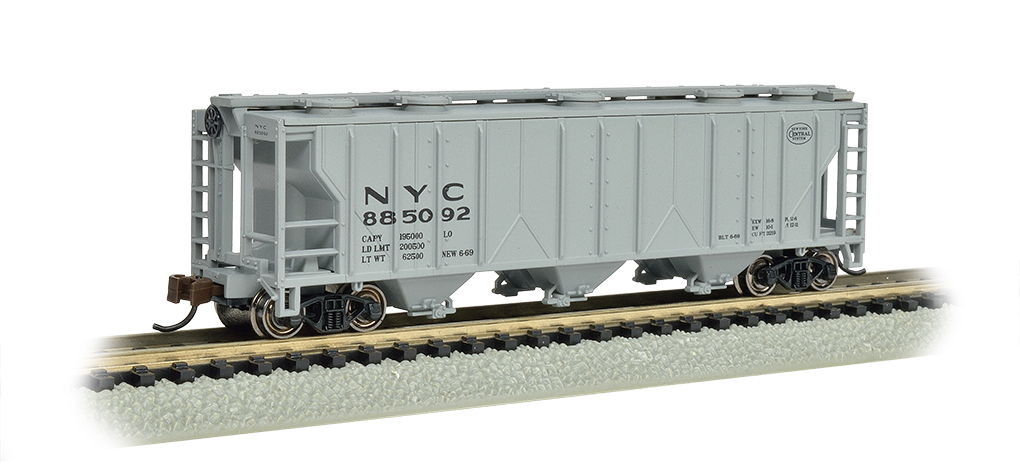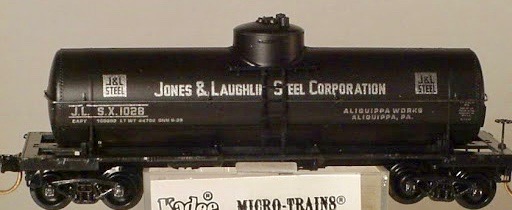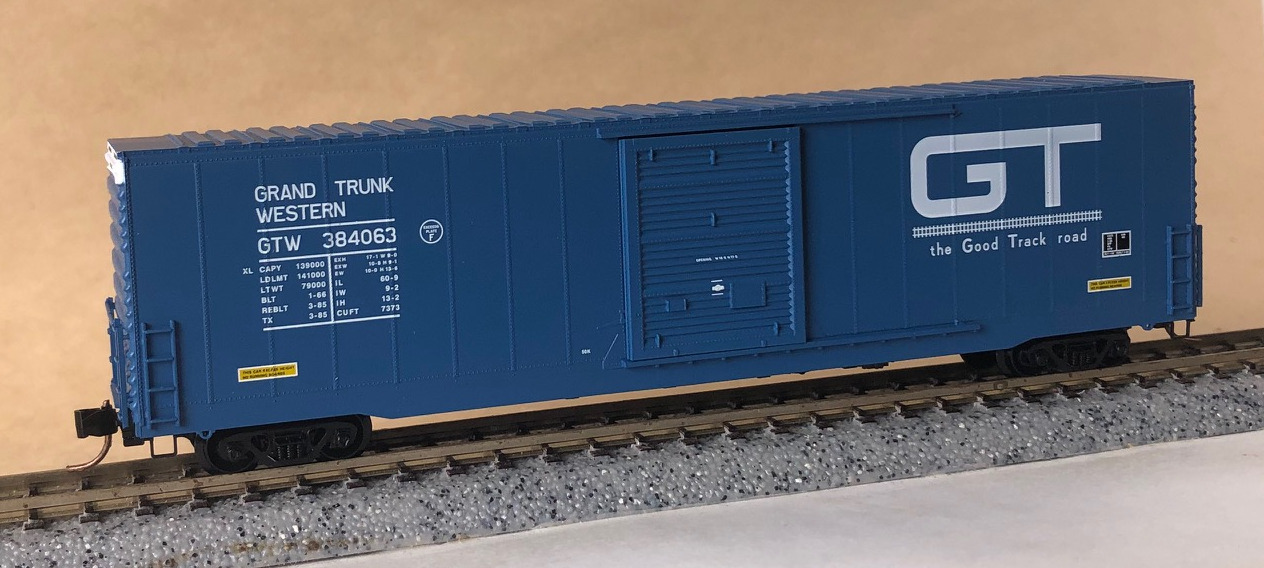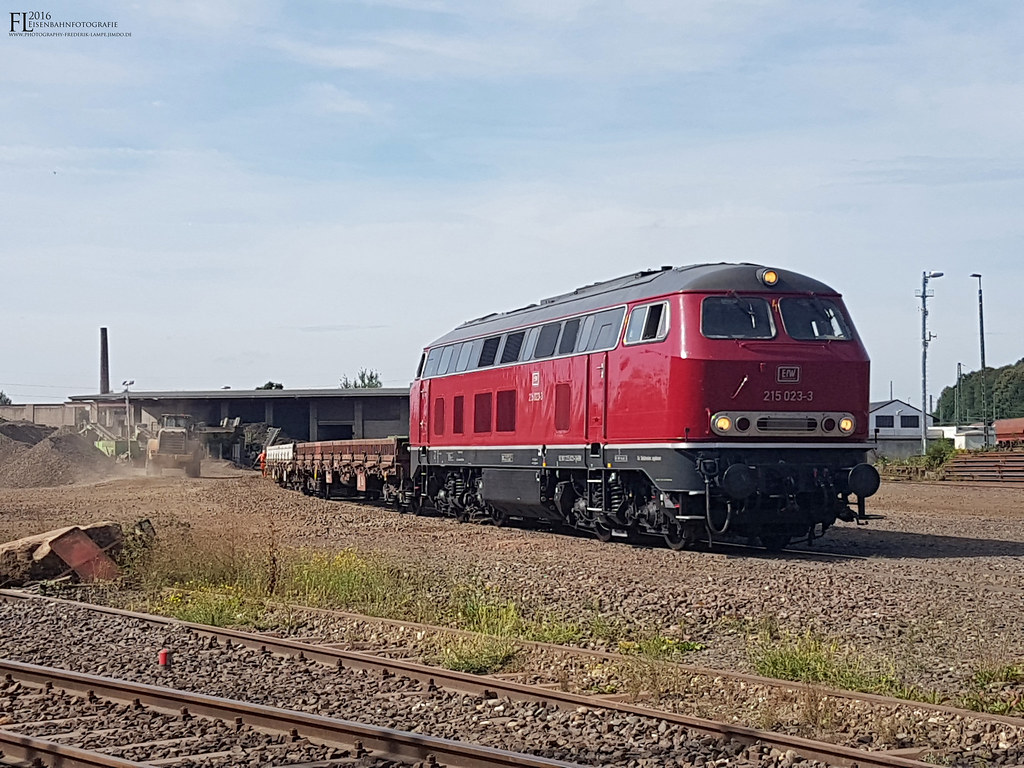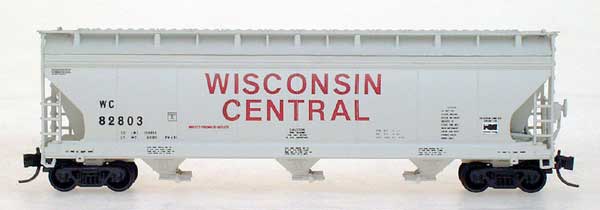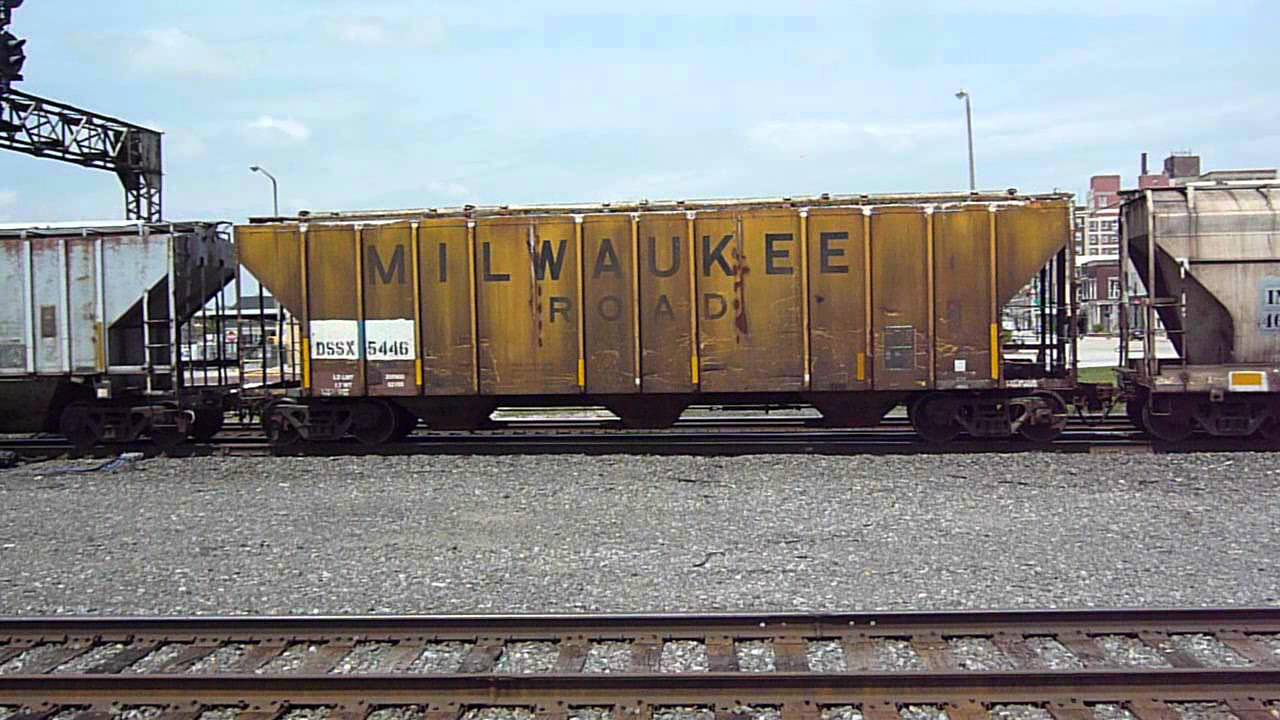Model Information: Bachmann originally released this body style in 1968 and marketed it as a 47 Foot 70 Ton hopper. It was released in 6 different road names with the standard nickel-silver plated wheels and Rapido couplers. One product number 5499 lists the road name as "assorted". My guess is that means you can get any one of the 6 road names in this box. Later catalogs ONLY list the assorted version. Again, my guess is that Bachmann was having trouble keeping all 6 road names in stock at all times.
More recently this car has been updated with EZ-Mate II couplers and blackened metal wheels. The new releases are marketed as a "PS-2 Three Bay Covered Hoppers". With five hatches on each side, a center mounted roofwalk, 3 bays, ribs and the same brake wheel placement, it is clear that this is the same car as the earlier 47 Foot 70 Ton Covered Hopper. Whether a new mold was created is anybody's guess, but with the long lifespan of this body style, it is likely the mold has been redone more than once in the near 50 year lifetime of this tooling.
More recently this car has been updated with EZ-Mate II couplers and blackened metal wheels. The new releases are marketed as a "PS-2 Three Bay Covered Hoppers". With five hatches on each side, a center mounted roofwalk, 3 bays, ribs and the same brake wheel placement, it is clear that this is the same car as the earlier 47 Foot 70 Ton Covered Hopper. Whether a new mold was created is anybody's guess, but with the long lifespan of this body style, it is likely the mold has been redone more than once in the near 50 year lifetime of this tooling.
Prototype History: Like their PS-1 boxcars, PS-5 gondolas and other car designs, Pullman Standard applied the PS-2 classification to all of its covered hoppers. Pullman Standard built covered hoppers in many sizes and configurations. But say “PS-2” to railfans and it is this particular car that usually first comes to mind. The 2003 cubic foot car was one of the first, smallest and prolific of the PS-2 cars.
Pullman began building its standardized freight car designs with the PS-1 boxcar in 1947. Next up would be a standard covered hopper – hence PS-2 – shortly thereafter. Although covered hoppers are among the most common cars on the rails today, in 1947 they were a rarity. The PS-2’s primary competition wasn’t other covered hopper designs but boxcars. Grain, cement, sand and dried chemicals were carried mostly in boxcars prior to the 1950s either in sacks and bags or poured in bulk through hatches in the roof. The theory here was that it made more sense to utilize a single car for a variety of products. The car could carry bags of cement one way and then cut lumber the other. Of course a car that could do many things often couldn’t do many of them well.
Pullman began building its standardized freight car designs with the PS-1 boxcar in 1947. Next up would be a standard covered hopper – hence PS-2 – shortly thereafter. Although covered hoppers are among the most common cars on the rails today, in 1947 they were a rarity. The PS-2’s primary competition wasn’t other covered hopper designs but boxcars. Grain, cement, sand and dried chemicals were carried mostly in boxcars prior to the 1950s either in sacks and bags or poured in bulk through hatches in the roof. The theory here was that it made more sense to utilize a single car for a variety of products. The car could carry bags of cement one way and then cut lumber the other. Of course a car that could do many things often couldn’t do many of them well.
Road Name History: The New York Central Railroad (reporting mark NYC), known simply as the New York Central in its publicity, was a railroad operating in the Northeastern United States. Headquartered in New York City, the railroad served most of the Northeast, including extensive trackage in the states of New York, Pennsylvania, Ohio, Michigan, Indiana, Illinois, and Massachusetts, plus additional trackage in the Canadian provinces of Ontario and Quebec.
The railroad primarily connected greater New York and Boston in the east with Chicago and St.Louis in the midwest along with the intermediate cities of Albany, Buffalo, Cleveland, Cincinnati, and Detroit. NYC's Grand Central Terminal in New York City is one of its best known extant landmarks.
1853 company formation: Albany industrialist and Mohawk Valley Railroad owner Erastus Corning managed to unite ten railroads together into one system, and on March 17, 1853 executives and stockholders of each company agreed to merge. The merger was approved by the state legislature on April 2, and by May 17, 1853 the New York Central Railroad was formed.
In 1867 Vanderbilt acquired control of the Albany to Buffalo running NYC. On November 1, 1869 he merged the NYC with his Hudson River Railroad into the New York Central and Hudson River Railroad. Vanderbilt's other lines were operated as part of the NYC.
In 1914, the operations of eleven subsidiaries were merged with the New York Central & Hudson River Railroad, re-forming the New York Central Railroad. From the beginning of the merge, the railroad was publicly referred to as the New York Central Lines. In the summer of 1935, the identification was changed to the New York Central System.
In 1968 the NYC merged with its former rival, the Pennsylvania Railroad, to form Penn Central (the New York, New Haven and Hartford Railroad joined in 1969). That company went bankrupt in 1970 and was taken over by the federal government and merged into Conrail in 1976. Conrail was broken up in 1998, and portions of its system was transferred to the newly formed New York Central Lines LLC, a subsidiary leased to and eventually absorbed by CSX and Norfolk Southern. Those companies' lines included the original New York Central main line, but outside that area it included lines that were never part of the New York Central system. CSX was able to take one of the most important main lines in the nation, which runs from New York City and Boston to Cleveland, Ohio, as part of the Water Level Route, while Norfolk Southern gained the Cleveland, Ohio to Chicago, Illinois portion of the line called the Chicago line.
At the end of 1925, the New York Central System operated 11,584 miles (18,643 km) of road and 26,395 miles (42,479 km) of track; at the end of 1967 the mileages were 9,696 miles (15,604 km) and 18,454 miles (29,699 km).
Read more on Wikipedia.
The railroad primarily connected greater New York and Boston in the east with Chicago and St.Louis in the midwest along with the intermediate cities of Albany, Buffalo, Cleveland, Cincinnati, and Detroit. NYC's Grand Central Terminal in New York City is one of its best known extant landmarks.
1853 company formation: Albany industrialist and Mohawk Valley Railroad owner Erastus Corning managed to unite ten railroads together into one system, and on March 17, 1853 executives and stockholders of each company agreed to merge. The merger was approved by the state legislature on April 2, and by May 17, 1853 the New York Central Railroad was formed.
In 1867 Vanderbilt acquired control of the Albany to Buffalo running NYC. On November 1, 1869 he merged the NYC with his Hudson River Railroad into the New York Central and Hudson River Railroad. Vanderbilt's other lines were operated as part of the NYC.
In 1914, the operations of eleven subsidiaries were merged with the New York Central & Hudson River Railroad, re-forming the New York Central Railroad. From the beginning of the merge, the railroad was publicly referred to as the New York Central Lines. In the summer of 1935, the identification was changed to the New York Central System.
In 1968 the NYC merged with its former rival, the Pennsylvania Railroad, to form Penn Central (the New York, New Haven and Hartford Railroad joined in 1969). That company went bankrupt in 1970 and was taken over by the federal government and merged into Conrail in 1976. Conrail was broken up in 1998, and portions of its system was transferred to the newly formed New York Central Lines LLC, a subsidiary leased to and eventually absorbed by CSX and Norfolk Southern. Those companies' lines included the original New York Central main line, but outside that area it included lines that were never part of the New York Central system. CSX was able to take one of the most important main lines in the nation, which runs from New York City and Boston to Cleveland, Ohio, as part of the Water Level Route, while Norfolk Southern gained the Cleveland, Ohio to Chicago, Illinois portion of the line called the Chicago line.
At the end of 1925, the New York Central System operated 11,584 miles (18,643 km) of road and 26,395 miles (42,479 km) of track; at the end of 1967 the mileages were 9,696 miles (15,604 km) and 18,454 miles (29,699 km).
Read more on Wikipedia.
Brand/Importer Information: Bachmann Industries (Bachmann Brothers, Inc.) is a Bermuda registered Chinese owned company, globally headquartered in Hong Kong; specializing in model railroading.
Founded in Philadelphia, Pennsylvania, the home of its North American headquarters, Bachmann is today part of the Kader group, who model products are made at a Chinese Government joint-venture plant in Dongguan, China. Bachmann's brand is the largest seller, in terms of volume, of model trains in the world. Bachmann primarily specializes in entry level train sets, and premium offerings in many scales. The Spectrum line is the high quality, model railroad product line, offered in N, HO, Large Scale, On30, and Williams O gauge all aimed for the hobbyist market. Bachmann is the producer of the famous railroad village product line known as "Plasticville." The turnover for Bachmann model trains for the year ended 31 December 2006 was approximately $46.87 million, a slight increase of 3.36% as compared to 2005.
Founded in Philadelphia, Pennsylvania, the home of its North American headquarters, Bachmann is today part of the Kader group, who model products are made at a Chinese Government joint-venture plant in Dongguan, China. Bachmann's brand is the largest seller, in terms of volume, of model trains in the world. Bachmann primarily specializes in entry level train sets, and premium offerings in many scales. The Spectrum line is the high quality, model railroad product line, offered in N, HO, Large Scale, On30, and Williams O gauge all aimed for the hobbyist market. Bachmann is the producer of the famous railroad village product line known as "Plasticville." The turnover for Bachmann model trains for the year ended 31 December 2006 was approximately $46.87 million, a slight increase of 3.36% as compared to 2005.
Item created by: gdm on 2016-11-06 12:01:06. Last edited by gdm on 2021-02-25 17:10:49
If you see errors or missing data in this entry, please feel free to log in and edit it. Anyone with a Gmail account can log in instantly.
If you see errors or missing data in this entry, please feel free to log in and edit it. Anyone with a Gmail account can log in instantly.


